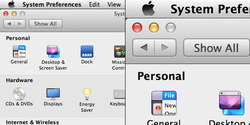Resolution independence
Resolution independence is a computing concept whereby elements on a computer screen are rendered at sizes independent from the pixel grid, resulting in a UI that is displayed at a consistent size, regardless of the size of the screen.
Concept
As early as 1978, the typesetting system TeX due to Donald Knuth introduced resolution independence into the world of computers. The intended view can be rendered beyond the atomic resolution without any artifacts, and the automatic typesetting decisions are guaranteed to be identical on any computer up to an error less than the diameter of an atom. This pioneering system has a corresponding font system, the Metafont, which provides suitable fonts of the same high standards of resolution independence.
The terminology Device independent file format is the file format of Donald Knuth's pioneering TeX system. The content of such a file can be interpreted at any resolution without any artifacts, even at very high resolutions not currently in use.
Implementation
OS X
Apple has included some support for resolution independence in earlier versions of OS X (formerly Mac OS X), which could be demonstrated with the developer tools Quartz Debug, which included a feature which allows the user to scale the interface. However, the feature was incomplete, as some icons will not show (such as in System Preferences), UI elements were displayed at odd positions and certain bitmap GUI elements are not scaled smoothly.[1] On June 11, 2012, Apple introduced the 2012 MacBook Pro with a new retina display (2880×1800), which doubles the resolution of OS X in every direction. [2] This laptop has a display which is resolution independent and provides options to scale the display by showing relative resolution. The display can be given more or less screen space whilst not changing the actual display resolution. [3]

Microsoft Windows
Microsoft Windows has supported DPI aware programs since Windows Vista[4] and allows user specified DPI settings for the windowing interface[5]
The Windows Presentation Foundation from Microsoft, and consequently, WPF applications, are also designed to be resolution-independent.
Other
Although not related to true resolution independence, some other operating systems use GUIs that are able to adapt to changed font sizes. Microsoft Windows 95 onwards used the Marlett TrueType font in order to scale some window controls (close, maximize, minimize, resize handles) to arbitrary sizes. AmigaOS from version 2.04 (1991) was able to adapt its window controls to any font size.[failed verification]
Video games are often resolution independent; an early example is Another World (video game) for DOS, which used polygons to draw its 2D content and was later remade using the same polygons at a much higher resolution. 3D games are resolution independent since the perspective is calculated every frame and so it can vary its resolution.
See also
- Display PostScript
- Fresco (computing)
- Metrics: Himetric and Twips
- Page zooming
References
- ^ Apple (April 29, 2005). "Resolution Independent UI Release Notes for Mac OS X v10.4". Apple Developer Connection. Retrieved 2007-03-25.
- ^ Anand Lal Shimpi (June 11, 2012). "MacBook Pro Retina Display Analysis". AnandTech. Retrieved 2012-06-12.
- ^ Anand Lal Shimpi (June 11, 2012). "How the Retina Display MacBook Pro Handles Scaling". AnandTech. Retrieved 2012-06-15.
- ^ "Win32 SetProcessDPIAware Function".
- ^ "Windows Vista DPI Settings".
External links
Declaration of resolution-independence by John Siracusa
